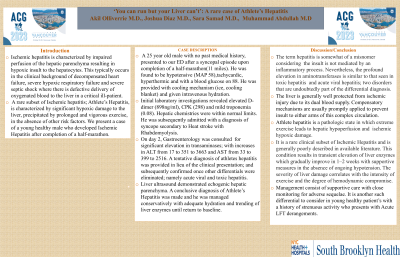Monday Poster Session
Category: Liver
P2451 - You Can Run, but Your Liver Can't: A Rare Case of Athlete's Hepatitis
Monday, October 23, 2023
10:30 AM - 4:15 PM PT
Location: Exhibit Hall

Has Audio

Akil Olliverrie, MBBS
South Brooklyn Health
Brooklyn, NY
Presenting Author(s)
Akil Olliverrie, MBBS1, Joshua Diaz, MD1, Sara Samad, DO2, John Trillo, MD3
1South Brooklyn Health, Brooklyn, NY; 2NYC Health + Hospitals, South Brooklyn Health, Brooklyn, NY; 3NYCHHC South Brooklyn Health, Brooklyn, NY
Introduction: Ischemic hepatitis is characterized by impaired hepatic parenchymal perfusion leading to hypoxic hepatocyte damage. This typically occurs in decompensated heart failure, hypoxic respiratory failure and septic shock with reduced delivery of oxygenated blood to the liver. A rare subset of ischemic hepatitis, athlete’s hepatitis, is characterized by hypoxic damage to the liver, precipitated by prolonged and vigorous exercise, without other risk factors. We present a case of a young healthy male developing ischemic hepatitis after completion of a half-marathon.
Case Description/Methods: A 25 year old male with no medical history, presented after he syncopized upon completion of a half-marathon. He was hypotensive, tachycardic and hyperthermic. Cooling blanket was applied and he was intravenously hydrated. Blood tests revealed D-dimer 898ng/ml, CPK 298 with LFTs within normal range. He was admitted for syncope secondary to heat stroke. On day 2 of admission Gastroenterology was consulted for elevated transaminases; ALT increased from 17 to 351 to 3663 and AST from 33 to 399 to 2516. A tentative diagnosis of athletes hepatitis was made in lieu of the clinical presentation once other differentials were ruled out including infectious, toxic and autoimmune hepatitis. US abdomen was unremarkable. A conclusive diagnosis of athlete’s hepatitis was made and he was managed conservatively with fluid hydration. Liver enzymes subsequently normalized and the patient was discharged.
Discussion: Ischemic or hypoxic hepatitis is characterized by the rapid rise is serum aminotransferases in response to an oxygen deficit to the liver. The elevation in aminotransferases is similar to that seen in toxic and viral hepatitis; two disorders considered in the differential diagnosis. The dual blood supply of the liver is protective as compensatory mechanisms usually prevent insult to either arms of its complex circulation. In athlete's hepatitis, intense exercise leads to hepatic hypoperfusion and hypoxia, more than can be compensated for, resulting in transient transaminitis. Improvement usually occurs in 1–2 weeks with supportive measures and reversal of hypoxia. It is a rare clinical subset of ischemic hepatitis and is rarely described in available literature. The severity of liver damage correlates with the intensity of exercise and the degree of hemodynamic compromise and hypoxia. This is a differential to consider in young healthy patient’s with a history of strenuous activity who present with acute LFT derangements.
Disclosures:
Akil Olliverrie, MBBS1, Joshua Diaz, MD1, Sara Samad, DO2, John Trillo, MD3. P2451 - You Can Run, but Your Liver Can't: A Rare Case of Athlete's Hepatitis, ACG 2023 Annual Scientific Meeting Abstracts. Vancouver, BC, Canada: American College of Gastroenterology.
1South Brooklyn Health, Brooklyn, NY; 2NYC Health + Hospitals, South Brooklyn Health, Brooklyn, NY; 3NYCHHC South Brooklyn Health, Brooklyn, NY
Introduction: Ischemic hepatitis is characterized by impaired hepatic parenchymal perfusion leading to hypoxic hepatocyte damage. This typically occurs in decompensated heart failure, hypoxic respiratory failure and septic shock with reduced delivery of oxygenated blood to the liver. A rare subset of ischemic hepatitis, athlete’s hepatitis, is characterized by hypoxic damage to the liver, precipitated by prolonged and vigorous exercise, without other risk factors. We present a case of a young healthy male developing ischemic hepatitis after completion of a half-marathon.
Case Description/Methods: A 25 year old male with no medical history, presented after he syncopized upon completion of a half-marathon. He was hypotensive, tachycardic and hyperthermic. Cooling blanket was applied and he was intravenously hydrated. Blood tests revealed D-dimer 898ng/ml, CPK 298 with LFTs within normal range. He was admitted for syncope secondary to heat stroke. On day 2 of admission Gastroenterology was consulted for elevated transaminases; ALT increased from 17 to 351 to 3663 and AST from 33 to 399 to 2516. A tentative diagnosis of athletes hepatitis was made in lieu of the clinical presentation once other differentials were ruled out including infectious, toxic and autoimmune hepatitis. US abdomen was unremarkable. A conclusive diagnosis of athlete’s hepatitis was made and he was managed conservatively with fluid hydration. Liver enzymes subsequently normalized and the patient was discharged.
Discussion: Ischemic or hypoxic hepatitis is characterized by the rapid rise is serum aminotransferases in response to an oxygen deficit to the liver. The elevation in aminotransferases is similar to that seen in toxic and viral hepatitis; two disorders considered in the differential diagnosis. The dual blood supply of the liver is protective as compensatory mechanisms usually prevent insult to either arms of its complex circulation. In athlete's hepatitis, intense exercise leads to hepatic hypoperfusion and hypoxia, more than can be compensated for, resulting in transient transaminitis. Improvement usually occurs in 1–2 weeks with supportive measures and reversal of hypoxia. It is a rare clinical subset of ischemic hepatitis and is rarely described in available literature. The severity of liver damage correlates with the intensity of exercise and the degree of hemodynamic compromise and hypoxia. This is a differential to consider in young healthy patient’s with a history of strenuous activity who present with acute LFT derangements.
Disclosures:
Akil Olliverrie indicated no relevant financial relationships.
Joshua Diaz indicated no relevant financial relationships.
Sara Samad indicated no relevant financial relationships.
John Trillo indicated no relevant financial relationships.
Akil Olliverrie, MBBS1, Joshua Diaz, MD1, Sara Samad, DO2, John Trillo, MD3. P2451 - You Can Run, but Your Liver Can't: A Rare Case of Athlete's Hepatitis, ACG 2023 Annual Scientific Meeting Abstracts. Vancouver, BC, Canada: American College of Gastroenterology.
